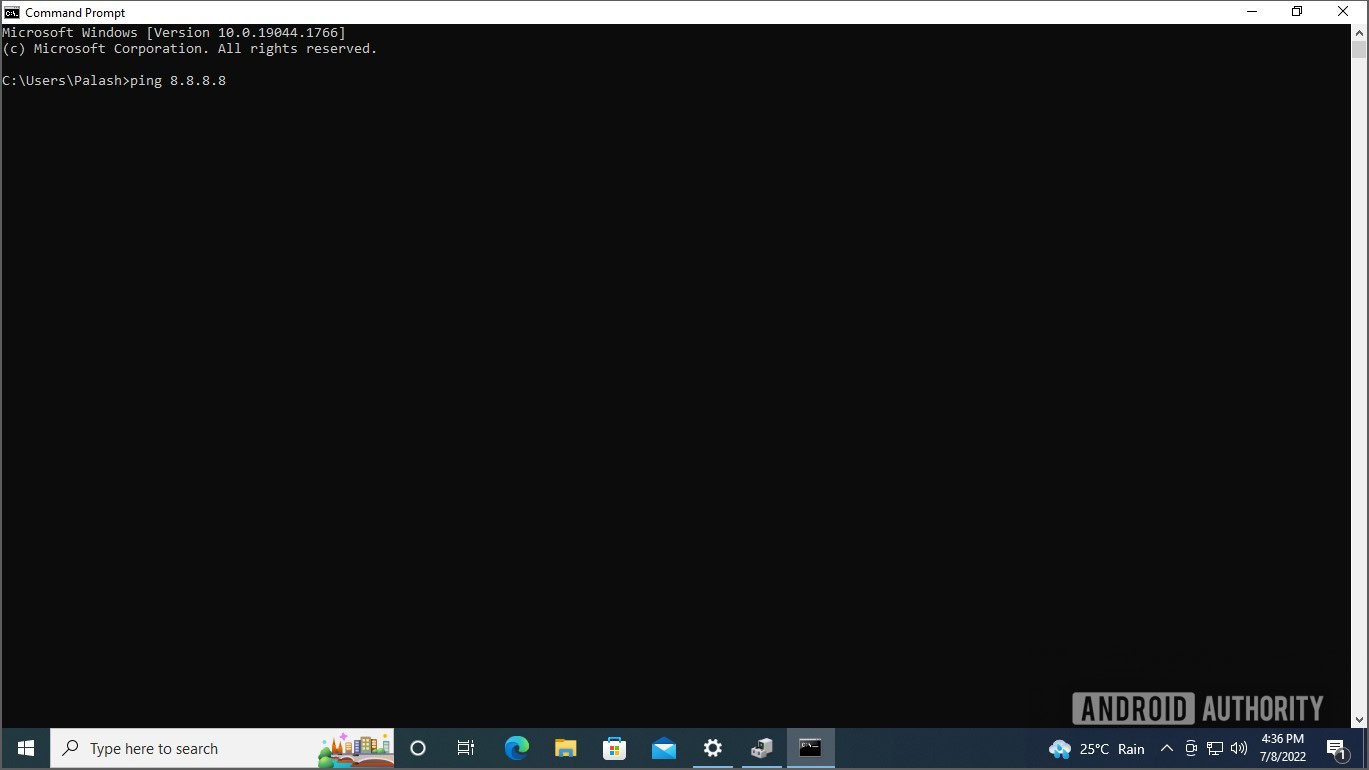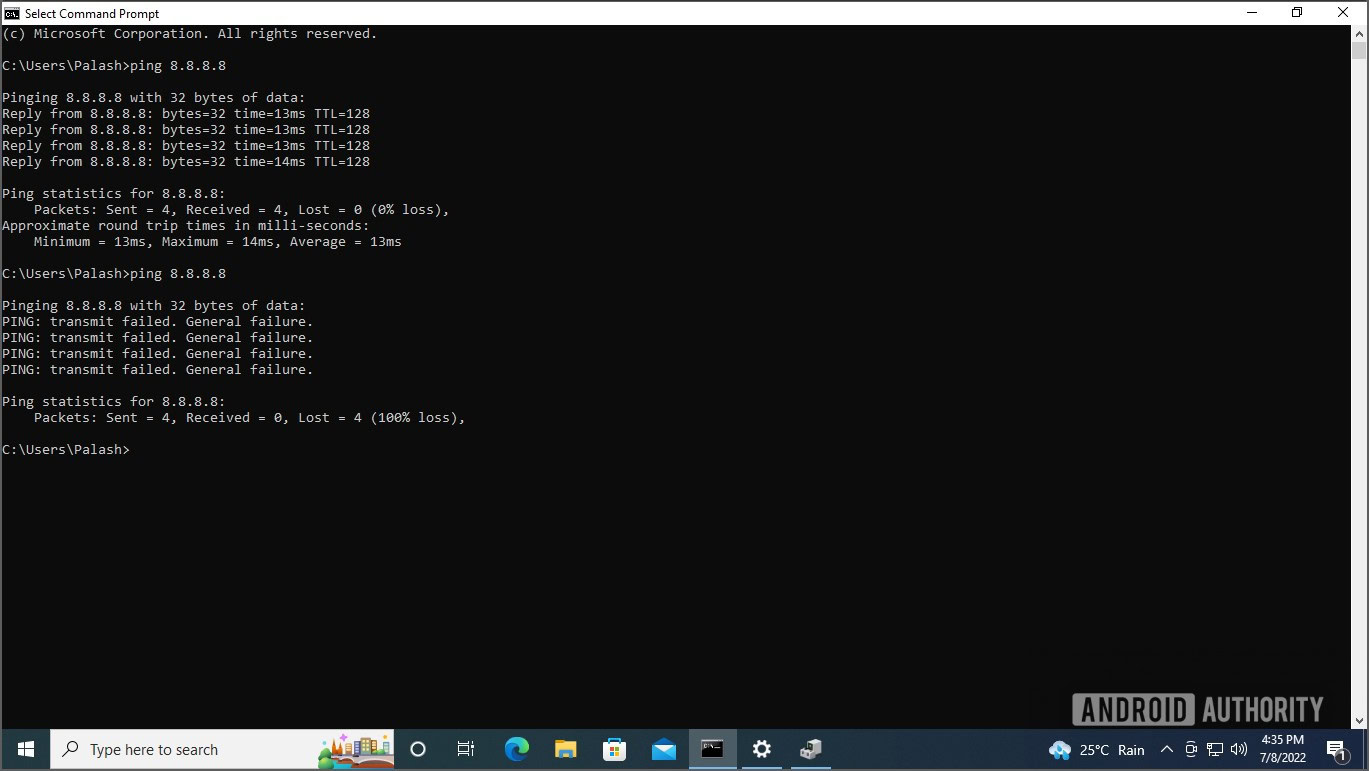Affiliate links on Android Authority may earn us a commission. Learn more.
How to do a ping test on Windows
Published onMarch 16, 2023
Internet connections can sometimes be somewhat finicky, and it can be tough to figure out if the issue is with your computer, with your Wi-Fi router, or if there’s something up with the connection itself. In such situations, ping tests can help determine if you’re connected to the internet and how stable your connection is. Here’s how to do a ping test on Windows.
QUICK ANSWER
To do a ping test in Windows, open the command prompt, type ping 8.8.8.8 , and press Enter. You can replace 8.8.8.8 with the IP address or website domain name you're trying to ping.
JUMP TO KEY SECTIONS
What is a ping test?
Ping is a measure of latency in a network. Measured in milliseconds, it’s the time a piece of data (usually 32 or 64 bytes) takes to go from one computer to another and back. A ping test is a test to ping a computer on the address using the associated IP address or domain name. A ping test can be a quick and easy way to check the connectivity and connection stability.
On Windows, a ping test also returns additional information about the connection like packet loss, minimum, maximum, and average ping time. These stats can also help give some further context as to why you might be experiencing network issues.
How to do a ping test on Windows

To do a ping test on Windows, follow these steps.
- Open the command prompt from Windows Search by typing command prompt or cmd, and click the top result.
- In the command prompt, type
ping <IP address or website you want to ping>and press Enter. For example,ping 8.8.8.8orping google.com. - Windows will carry out the ping test, and you will be able to see it in progress, the result, and some accompanying stats when finished.
How to read ping test results

A ping test in Windows will return the results along with some stats. Here are the important parts of the output.
- Size of data: The ping test specifies how much data is being pinged, usually 32 bytes.
- Time: This figure refers to the ping itself, measured in milliseconds—for example, 13ms, as seen in the screenshot above.
- TTL: This is the Time To Live, which traces the route of the packet of data as you ping it. It reports how many hops it could do before being discarded. The maximum value is 128. The value CMD displays are the number of remaining hops.
- Packets sent and received: This is how often the data is pinged, typically four times, labeled as Packets Sent and Received. The numbers for both should be the same for a successful test, and a lower received figure indicates issues with the connection, with zero signifying a loss of connection. The loss represents the number of packets lost, with a percentage figure to go with it.
- Ping stat figures: Minimum shows the best ping figure, Maximum shows the worst ping figure, and Average shows the mean ping figure, which we generally consider the key result of the ping test.
Common ping error messages
A transmit failed, or Request timed-out message will indicate a failed ping test. That could either mean your connection has issues or the address you’re trying to ping is unavailable.
An unknown host error indicates that the host is not recognized. You can check if the name of the website is properly typed. It could also mean that the DNS lookup for the website failed, indicating that either the DNS is not set up properly on your computer, or that there is something wrong with the website.
A destination host unreachable error indicates that a route to the destination could not be found. Possible solutions for the same include checking if your TCP/IP configuration is correctly set.
We hope this guide has been helpful to you in diagnosing your internet issues. If you’d like to see some more helpful guides, you can see how you can upgrade to Windows 11, open the task manager and execute the various functions within, or go advanced and see how you can disable startup applications on Windows.
FAQs
The best way to do this is in the game itself. Most games with online components will have a network stats setting somewhere. If not, they’ll at least display the pings according to the server in the server selection.
We recommend the Google DNS addresses, 8.8.8.8 or 8.8.4.4. You can also ping your frequently visited websites.
Simply type the ipconfig command in the Windows command prompt to list all your IP addresses on Windows.